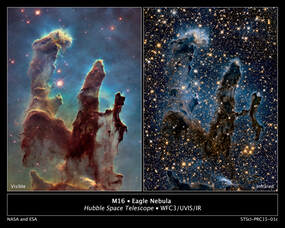“What you need to know about the James Webb Space Telescope“ -- Olu Thomas, 8th grade

James Webb Space Telescope, (named after James E. Webb) is a new space telescope launched by NASA (National Aeronautics and Space Administration), and ESA (European Space Agency). Webb will be able to look farther into space than ever before, and therefore further back closer to the big bang to teach us more about our planet, the planets around us, and if other planets could have the right ingredients for life as we know it. JWST (James Webb Space Telescope) was launched by ESA on a Ariane 5 rocket on December 25th, 2021. A great holiday gift for space fans far and wide, and will definitely be a great tool for scientists to use to understand the universe.
Space telescopes, or observatories as they are less commonly referred to, are basically large mirrors that collect large amounts of light and using science and stuff they turn it into photos.
There are different types of light in the solar system including but not limited to visible light, which is the light you see every day, infrared light which is electromagnetic radiation, and can not be seen by the human eye. There are also many more light spectrums. In the photo to the left you can see some differences between visible, and infrared.
Space telescopes, or observatories as they are less commonly referred to, are basically large mirrors that collect large amounts of light and using science and stuff they turn it into photos.
There are different types of light in the solar system including but not limited to visible light, which is the light you see every day, infrared light which is electromagnetic radiation, and can not be seen by the human eye. There are also many more light spectrums. In the photo to the left you can see some differences between visible, and infrared.
James Webb will in fact not orbit the earth like many other space telescopes, instead Webb will be in Earths Lagrange 2 point. What this means is that it will be orbiting the sun while inline with earth. It will fly over the Earth’s poles, but in the sun's solar orbit, while still affected by the earth’s gravitational fields. Webb can be far enough away from our planet to not be affected by the light and heat from the earth and moon. This would blur photos taken from Webb as it picks up on heat traces. But it must remain close enough that it can still communicate with ground stations on earth easily. James Webb launched on an Arian 5 rocket, a very reliable rocket, built by the European Space Agency. As said by Arian Space, the rocket is similar to the space shuttle in that it has a hydrogen powered first stage, solid rocket boosters and a small second stage akin to the orbital maneuvering engines on the space transportation system.
Webb has a five segment heat shielding system which makes sure that the spacecraft’s mirrors and other instruments can work at maximum capacity because of the fact that Webb will be looking into the infrared light spectrum. Meaning light and heat from the earth, sun, and moon cannot interfere with Webbs instrumentation.
Is James Webb the successor to the Hubble Space Telescope, launched on April 24, 1990? Not quite, as we have established JWST (James Webb Space Telescope) looks into the infrared light spectrum while Hubble looks into the visible light spectrum, which is light that can be seen by the human eye. The Spitzer Space Telescope, one of the most advanced telescopes to be put into orbit, also looked into the infrared light spectrum but was much smaller. Webb is more similar to the Spitzer Space Telescope than anything else.
NASA has launched one of the most exciting, expensive and overall greatest wonder of modern engineering and science. If it can last as long as Hubble has in space then we have a lot of science ahead of us.
Webb has a five segment heat shielding system which makes sure that the spacecraft’s mirrors and other instruments can work at maximum capacity because of the fact that Webb will be looking into the infrared light spectrum. Meaning light and heat from the earth, sun, and moon cannot interfere with Webbs instrumentation.
Is James Webb the successor to the Hubble Space Telescope, launched on April 24, 1990? Not quite, as we have established JWST (James Webb Space Telescope) looks into the infrared light spectrum while Hubble looks into the visible light spectrum, which is light that can be seen by the human eye. The Spitzer Space Telescope, one of the most advanced telescopes to be put into orbit, also looked into the infrared light spectrum but was much smaller. Webb is more similar to the Spitzer Space Telescope than anything else.
NASA has launched one of the most exciting, expensive and overall greatest wonder of modern engineering and science. If it can last as long as Hubble has in space then we have a lot of science ahead of us.


